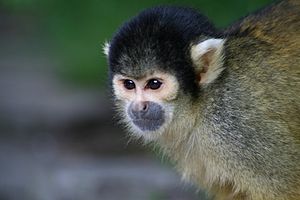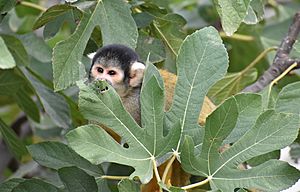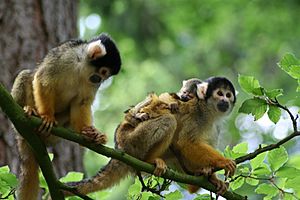Black-capped squirrel monkey facts for kids
Quick facts for kids Black-capped squirrel monkey |
|
|---|---|
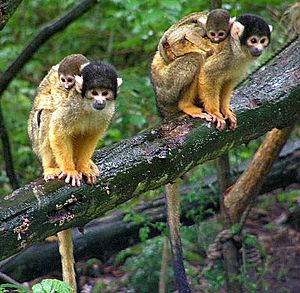 |
|
| Conservation status | |
| Scientific classification | |
| Genus: |
Saimiri
|
| Species: |
boliviensis
|
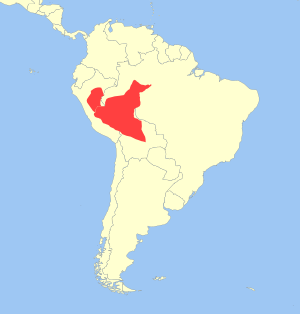 |
|
| Geographic range | |
| Synonyms | |
|
|
The black-capped squirrel monkey (also known as Saimiri boliviensis) is a type of New World monkey. These monkeys live in the Amazon rainforest. You can find them in Bolivia, western Brazil, and eastern Peru.
These monkeys are quite small. They weigh from about 365 to 1135 grams. From head to the base of their tail, they are about 22.5 to 37 centimeters long. Black-capped squirrel monkeys mostly live in trees. They can be found in natural forests, tree farms, and even some farmed areas near rivers.
They eat many different things, which means they are omnivores. Their diet includes flowers, fruits, leaves, nuts, and seeds. They also eat insects, spiders, eggs, and small animals. These monkeys usually live in groups of 40 to 75. These groups are mostly led by females. Male monkeys often leave their birth group when they grow up. They then join groups made up only of males. Later, they might join a mixed-sex group. The black-capped squirrel monkey is currently listed as 'Least Concern' by the IUCN. This means they are not in immediate danger of disappearing.
Contents
What Do They Look Like?
Black-capped squirrel monkeys show sexual dimorphism. This means males and females look a bit different. Males are usually heavier, weighing between 550 and 1135 grams. Females weigh less, from 365 to 750 grams. Baby monkeys weigh about 80 to 140 grams when they are born.
Adult males are about 25 to 37 centimeters long from head to tail base. Females are a bit shorter, from 22.5 to 29.5 centimeters. Their fur is short, soft, and thick. Most of their back fur is grey or olive-brown. Their bellies are usually white, yellow, or a brownish-orange color. Their heads are black with white arches above their eyes. Their tails are the same color as their bodies. The tip of the tail is black and bushy. The tail is not used for gripping things. It is usually about 35 to 42.5 centimeters long.
Black-capped squirrel monkeys look very similar to other squirrel monkey species. However, you can tell them apart by a few things. The most obvious features are their dark black cap and the white "Roman type" arch above their eyes. This arch is narrower and more rounded than the "Gothic type" arch seen in other species. The tail of the "Roman type" species is also thinner.
Where Do They Live?
Black-capped squirrel monkeys with the "Roman arch" face pattern are found in most of Bolivia. They also live in northern Peru and between the Jurua and Purus Rivers in Brazil. They prefer lowland tropical rainforests near water. These areas are often dense forests or swampy regions.
They spend most of their time in trees. They use all parts of the forest canopy. However, they are often seen in the lower parts of the trees. This is where they travel and look for food. It is thought that female-led groups of these monkeys form because there is plenty of fruit and insects in their habitat. This is different from other squirrel monkey species.
How Do They Live?
Black-capped squirrel monkeys mostly live in trees. But sometimes, they will come down to the forest floor. They are diurnal, meaning they are active during the day. They are most active in the early to mid-morning. Then they rest for an hour or two in the afternoon. After their rest, they become active again until evening.
Social Life
Black-capped squirrel monkeys live in groups of about 45 to 75 monkeys. These groups are usually led by females. This is different from the Common squirrel monkey, which often lives in male-led groups. Like most monkeys, female black-capped squirrel monkeys usually stay in the group where they were born. Males are more likely to be pushed out by dominant females.
When male black-capped squirrel monkeys become adults, they leave their birth group. They join smaller groups made up only of males. Eventually, they might join a larger group with both males and females. Black-capped squirrel monkey groups can have a lot of fighting between females. Females often compete with each other for food and other resources. Even with this competition, they prefer to live in large groups. This helps them stay safer from predators.
Babies and Family
Female black-capped squirrel monkeys usually become ready to have babies around 3 years old. Males are ready around 5 years old. The mating season happens during the dry season. Usually, each mother will have one baby.
During mating season, male monkeys gain a lot of fat on their upper bodies. This makes them look "fatted." Males also become more easily annoyed and aggressive. They fight more often to show who is in charge of the group. A female monkey's smell and actions help a male know if she is ready to mate. If she is not ready, the female will usually chase the male away. Sometimes, other nearby females will help her.
A baby monkey stays inside its mother for about 160 to 170 days. For the first week after birth, the baby monkey clings to its mother's back. It rarely moves or is cared for by the mother unless it needs help.
Talking to Each Other
Squirrel monkeys are known for being very vocal. They make many different sounds throughout their lives. Common sounds include "chucks," purrs, and squawks. These are heard during birth and mating seasons. They also make chirps and peeps for alarms or to get attention. They can also make aggressive screams and "barks."
Baby black-capped squirrel monkeys talk much more than adults. The most common sound from babies is different "peeps." These sounds happen most often around 2 months old. This is when babies start to spend more time away from their mothers. For adult females, the most common sound is a variety of "chucks." They use these sounds to stay in touch in thick forests where they cannot see each other.
Food and Finding It
Black-capped squirrel monkeys eat both plants and animals. Their diet usually includes fruits, insects, eggs, small animals, spiders, leaves, flowers, nuts, and seeds. They rarely eat fungi. However, they seem to prefer insects over fruit.
Adult squirrel monkeys spend most of their day looking for food. They start foraging about 40 to 60 minutes before sunrise. They spend the first part of the day actively eating fruits and hunting insects. Later, they eat more slowly and spend the rest of the day resting and hunting for more insects. If there is plenty of food, they often stop and rest for an hour or two in the middle of the day when it is too hot. When fruits are hard to find, squirrel monkeys have been seen eating a type of fungus. This fungus grows on insects that live on bamboo. Researchers think they do this to find food during dry seasons.
How They Move
Black-capped squirrel monkeys are mostly found in trees. They often leap 1 to 2 meters between branches. They can move quickly through thick plants. They walk or run on all four legs. Their hind leg on one side touches down, followed by the front leg on the opposite side. Sometimes, they stand on two legs on the ground while looking for food. The monkey's tail is usually used for balance. Baby monkeys also use their tails to hold onto their mother's tail or belly.
Are They Safe?
The black-capped squirrel monkey population is listed as 'Least Concern' by the IUCN. This is true even though their numbers are generally going down. It has been found that these monkeys can adapt well to changes in their environment. People also do not hunt them much.
According to the IUCN, the main threats to their homes are farming and fish farming. Also, people using the monkey's natural resources, like hunting, trapping, logging, and wood harvesting, can harm them.
Images for kids
See also
 In Spanish: Mono ardilla boliviano para niños
In Spanish: Mono ardilla boliviano para niños



